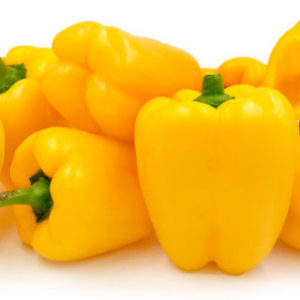Content
- 1 The chemical composition of bell pepper
- 2 Nutritional value and calorie content of bell pepper
- 3 Useful and medicinal properties of bell pepper
- 4 At what age can bell peppers be given to children
- 5 Is bell pepper good for pregnancy?
- 6 Is bell pepper possible for nursing mothers
- 7 Bulgarian pepper for weight loss
- 8 The benefits of bell pepper depending on the color
- 9 Which pepper is healthier: sweet or bitter
- 10 In what form is it better to use bell pepper
- 11 Daily intake
- 12 Features of the use of bell pepper for diseases
- 13 The benefits of bell pepper for facial skin
- 14 How to choose the right bell pepper
- 15 How to store bell peppers at home
- 16 Conclusion
Bell peppers have been cultivated for hundreds of years. Many people love this bright and juicy vegetable for its unusual taste and the ability to use it in any form. But at the same time, not everyone knows what the benefits and harms of bell pepper are.
It was originally grown in America, after which it was transported to Europe and Russia. The plant belongs to the annual species of the Solanaceae family. Depending on the variety, fruits can have different shapes and colors.

The chemical composition of bell pepper
Bell pepper is a unique plant. Its fruits are rich in essential vitamins and minerals.
Chemical composition:
- vitamin A has a positive effect on eyesight and also has an antioxidant effect;
- vitamin PP is useful for the work of the heart and blood vessels, stabilizes the level of cholesterol in the blood;
- vitamin C supports the body's immune forces and protects against infections;
- B vitamins, necessary for the nervous system, help to improve memory and increase stress resistance;
- vitamin E has a rejuvenating effect, accelerates the process of tissue regeneration;
- vitamin K affects blood clotting, helps restore bone tissue, and also participates in the exchange of calcium in the body;
- beta-carotene is a very powerful antioxidant, necessary for maintaining vision and maintaining the body's defenses;
- potassium fights sclerosis, removes accumulations of salts from the body;
- calcium is important for the health of teeth and bones, is involved in the supply of nerve impulses;
- phosphorus is essential for the life of cells;
- magnesium supports the work of the cardiovascular system, distributes calcium and participates in the formation of bone tissue;
- Sodium is required for optimal nerve impulse function;
- iron is involved in gas exchange processes in cells, it is necessary for the formation of hemoglobin;
- copper is necessary for the production of red blood cells, supports immunity;
- manganese stabilizes blood glucose levels, as it takes part in the production of necessary enzymes;
- selenium supports the health and function of the heart muscles;
- zinc raises immune forces and accelerates tissue regeneration.
The content of certain elements differs depending on the plant variety.
Nutritional value and calorie content of bell pepper
Pepper is a low-calorie food. Therefore, it is an integral part of the diet.On average, the calorie content per 100 grams of bell pepper is about 25 kcal. Nutritional value: proteins - 1.3 g, fats - 0 g, carbohydrates - 5.5 g.
The calorie content of a vegetable varies, depending on the color:
- red - 26.8 kcal;
- yellow - 27.2 kcal;
- green - 23.2 kcal.
The type of processing also affects the calorie content of the product:
- boiled - 26 kcal;
- baked - 34 kcal;
- fried - 106 kcal;
- stewed - 29 kcal;
- lecho - 32.6 kcal.
When cooked, the vegetable loses some of its beneficial properties. Vegetable fats increase calories. Therefore, the benefits of roasted bell peppers will be much less than that of fresh vegetables.
Useful and medicinal properties of bell pepper
Due to its unique composition, the fruits are very useful for the human body. This plant has a wide range of medicinal effects in many areas.
For human health, the benefits of bell pepper are as follows:
- improves immunity;
- serves as the prevention of oncological diseases;
- improves blood composition;
- normalizes appetite and the digestive system;
- maintains visual acuity;
- normalizes blood pressure;
- helps the functioning of the nervous system, relieves depression well;
- improves memory.
Why is bell pepper useful for women
Red pepper is very beneficial for women:
- The plant helps to eliminate discomfort during menstruation, reduces mood swings. It is useful to use at any age.
- Has a beneficial effect on the condition of the hair. The constant use of vegetables makes hair smooth, healthy, eliminates dandruff and split ends.
- Calcium in the vegetable helps to strengthen bones and teeth, smooth wrinkles and heal wounds.
- Favorably affects the female reproductive system. Its use normalizes the functioning of the genitals.
The benefits of bell pepper for men
The fetus is no less useful for men's health:
- Regular consumption of the vegetable increases potency and normalizes the functioning of the genitals, increases sperm production.
- The beneficial substances in the plant protect the heart and reduce the risk of thrombosis.
- Eating peppers is good for improving memory and brain function.
- The plant helps to cope with depression and fatigue, improves mood and performance.
At what age can bell peppers be given to children
Small children need to be given peppers with great care. The plant can be harmful - cause an allergic reaction or disrupt the functioning of the gastrointestinal tract.
In the first year of life, it is not recommended to give your child a fresh vegetable. From 10 months of age, it is allowed to add pepper to the baby's diet in the form of a boiled vegetable puree. A child can be introduced to a fresh vegetable no earlier than 1.5 years.

Is bell pepper good for pregnancy?
Red bell peppers are very beneficial during pregnancy. The vegetable contains a large amount of essential substances that are important during the period of bearing a baby. In addition, it helps to cope with depression and nervous tension, improve the functioning of the digestive tract and increase immunity.
Pepper contains a lot of iron and helps to cope with anemia, which is very common during pregnancy. In addition to providing vitamins to the mother's body, pepper contributes to the proper formation and development of the fetus due to the content of folic acid in its composition. But excessive use of it can be harmful to health. Before use, be sure to consult a doctor.
Is bell pepper possible for nursing mothers
During lactation, it is also very beneficial for women to consume pepper in their diet.A large amount of vitamins, especially vitamin C, helps to recover from childbirth and cope with depression.

Due to the high tendency to allergies, the product should be administered with caution. A nursing mother should adhere to the following rules:
- It is allowed to enter it into the diet only after the baby is 3 months old.
- Start with small portions and monitor your child's reactions.
- The first time requires heat treatment of the vegetable - stewing, boiling or baking.
- In the absence of a negative reaction of the child to the vegetable, it is allowed to increase the portions and introduce the plant fresh.
Bulgarian pepper for weight loss
Pepper is a dietary food because it contains very little sugar and calories. The most nutritious is the yellow fruit, the least - the green one. However, green vegetables are considered unripe and therefore contain fewer nutrients than yellow or red ones.
There are many different diets based on bell peppers. Its use provides the body with the necessary substances, cleanses of toxins and promotes rapid weight loss due to its low calorie content.

Vegetable juice is often used in dietary meals. Bell pepper juice contains a concentration of all the benefits of a vegetable. It should be drunk 50 ml daily. Such a remedy helps not only to lose weight, but also to lower cholesterol, strengthen hair and nails and charge the body with vitamins.
The benefits of bell pepper depending on the color
No one doubts the benefits of this ardent and juicy fruit. But few people know that the benefits of bell pepper for the human body differ depending on the color of the fruit.
Red bell pepper
The fruits of red bell pepper are very useful in that they contain the greatest amount of vitamins C and A. Due to this, they are very useful for enhancing immunity and for maintaining visual acuity. A special substance - lycopene - gives brightness to the color. It is a powerful antioxidant and helps slow down the aging process of cells.

The red fruit should be used with caution by people with allergies and stomach problems.
Yellow bell pepper
Yellow fruits contain a lot of carotene, potassium and phosphorus. These peppers are very useful for the elderly as they protect the heart and blood vessels. In addition, it is useful to consume the yellow vegetable during periods of mental stress, as it improves memory and concentration, fights depression and insomnia.

Yellow bell pepper also benefits from its high iron content, which helps in treating anemia, and its high concentration of lutein for visual acuity.
Green bell pepper
Green fruits are dietary. They contain many phytosterols that normalize fat metabolism. The calorie content of such a vegetable is only 23 kcal, which makes it an indispensable product for a diet.

Additional benefits of green bell peppers:
- stabilizes cholesterol levels;
- removes toxins;
- increases the elasticity of the walls of blood vessels;
- accelerates all metabolic processes.
The color of the fruit may have other colors. Such varieties are the result of the selection of gardeners. The benefits of purple or orange bell peppers will be no less than from vegetables of the usual shades.
Which pepper is healthier: sweet or bitter
The bitter fruit practically does not differ in its benefits from the sweet one. It also contains many beneficial substances. To replenish the reserves of vitamins and minerals, a person needs to eat several fruits of pepper per day.

This is a real problem, because not everyone can eat even one whole fruit. When a large amount of hot pepper is consumed, severe irritation of the gastrointestinal tract mucosa occurs, which can lead to complications up to ulcerative lesions.Therefore, bitter peppers are used mainly as a spice in a low concentration in cooking.
In what form is it better to use bell pepper
To preserve all the nutrients in bell peppers, it is best to consume it fresh. During heat treatment, the amount of trace elements and vitamins decreases. The benefits of boiled bell peppers will be about 70% less than fresh ones. This is especially true of vitamin C: it is destroyed by high temperatures.

But for some diseases of the gastrointestinal tract, it is forbidden to eat fresh vegetables, which, in an unprocessed form, can aggravate the situation. In this case, it is necessary to subject it to processing as little as possible in order to preserve all the benefits. For example, immerse in already boiling water, avoiding boiling.
Despite the fact that some of the benefits decrease after processing, it is still recommended to use it in any form - baking, canning, stewing, etc.
It is believed that you can not eat bell pepper seeds. The reason for this is the opinion about their toxicity and harm to health. But it has been scientifically proven that bell pepper seeds have no less health benefits than the fruits themselves. They can be dried, crushed and added to food.

The fruits themselves can be frozen. Frozen bell peppers retain all their benefits for a long time. After defrosting, it can also be boiled, stewed, baked, etc.
Daily intake
Despite all the benefits of the vegetable, it should not be consumed in large quantities. It is recommended to eat up to 2-3 pieces per day. or about 150 g. In case of a possible allergic reaction, this amount should be reduced to 1 pc.
Features of the use of bell pepper for diseases
The use of sweet pepper brings not only benefits to the human body, but also harm. The plant has certain contraindications and requires certain precautions. For some diseases, you need to use it very carefully so as not to harm your health.
With diabetes mellitus
In the presence of diabetes mellitus, sweet peppers can not only be consumed, but also necessary. It saturates the body with useful substances and normalizes glucose metabolism. With diabetes, it is allowed fresh or baked, but it is better to refuse fried or pickled options.
With gout
The diet for gout is very similar to the diet for diabetes. In this case, it is also very useful and helps to alleviate the patient's condition. Before use, it is imperative to consult a specialist.
It is allowed to use the plant fresh, baked or stewed. Frying and pickling are prohibited, as they can worsen the patient's well-being.
With gastritis
Gastritis is an inflammation of the stomach lining. In such situations, patients are prohibited from eating the sharp type of plant. Limited quantities of sweet varieties are allowed.
In case of exacerbations of the disease, it is better to refuse to take dishes with pepper or subject the vegetable to a thorough heat treatment. This will help to reduce the vitamin C content and reduce the negative effects on the stomach.
With pancreatitis
With pancreatitis, gentle nutrition is required that will not irritate the diseased organ. Pepper promotes the production of enzymes and can worsen the patient's condition. During the period of exacerbation, the vegetable is strictly prohibited, during remission it is allowed to use it stewed or boiled.
The benefits of bell pepper for facial skin
The fruits of the plant are widely used for cosmetic purposes. The high content of vitamins has a rejuvenating, tonic and regenerating effect on the skin. After masks based on pepper, wrinkles are smoothed, complexion refreshed, and pores are cleansed.
The vegetable is suitable for all skin types.It is recommended to do masks at least once a week. An allergy test is recommended prior to application.
Bell pepper mask for face
Examples of masks:
- Toning mask. Peel the washed vegetable from seeds, grate or grind in a blender, apply the gruel to a napkin or gauze and then apply on the face. Leave it on for 15-20 minutes. Then rinse with warm water or herbal decoction.
- Purifying mask. Grind the washed fruit, add protein from 1 egg and a tablespoon of kefir. Apply the resulting mixture to the face and leave for 20 minutes. Then rinse thoroughly and apply a nourishing cream.
- Whitening mask. Add a few drops of lemon juice to the gruel of crushed pepper and apply on face. Only areas with pigmentation can be treated with the product. Wash off with a damp cloth.
Bell pepper juice tonic
An excellent daily care product is a pepper juice toner. To prepare it, you need to mix a couple of tablespoons of the crushed fruit of the plant and 1/4 cup of low fat milk. Let it brew for half an hour. Store the finished tonic in the refrigerator. Moisten a cotton swab in the product daily and wipe your face well. After the procedure, wash with water.
How to choose the right bell pepper
The freshness of the vegetable is very important. You should always check the quality of the pepper when you buy it. The following tips will help with this:
- the surface of the vegetable should be smooth and shiny, even minor damage will lead to rapid decay;
- the green color of the ponytail is evidence of freshness;
- the vegetable must be firm;
- The skin must be dry and free of plaque.

How to store bell peppers at home
The right conditions will increase the shelf life of fresh vegetables. The main storage rules are:
- air humidity from 60 to 90%;
- temperature from 0 to + 2 ° С;
- an unripe vegetable can be put in a dark and cool place for ripening;
- store ripe fruit only in the refrigerator;
- for long-term storage, it can be frozen.
Conclusion
Bell peppers or bell peppers bring both benefits and harm to the body. Despite the long list of beneficial effects, the plant must be used with caution.

